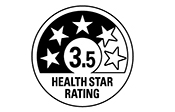
Reading food labels
Key takeaways
2 min read
- Use nutrition information panels and ingredient lists to compare similar foods so you can choose the healthiest option.
- The quantity per 100g or 100ml column is best when comparing different brands of similar products. You can also compare products using the Health Star Rating.
- For heart health, look for low salt and low saturated and trans fat products.
- Look out for nutrition claims on the front of food labels - these can grab your attention but can sometimes be misleading. Always double-check the claims by looking at the nutrition information panel.
How to read food labels
Nutrition information panels and ingredients lists are a good way to compare similar foods and choose the best option for you. You’ll find them on almost all packaged foods, and they must meet government standards, ensuring the information is reliable.
For people aiming to make heart-healthy choices, the nutrition information panel is most useful to choose products lower in salt and avoid those high in saturated and trans fats.
Read our tips to better understand food labels and spot key nutrients and ingredients like saturated fat and salt.
What’s included on a Nutrition Information Panel

What to look out for on food labels
1. Pay attention to salt & fats
For a healthy heart, it's important to choose foods that are lower in salt, and unhealthy fats like saturated and trans fats.
Salt is listed as sodium on the nutrition panel. Use the per 100g/ml column to compare products and choose the one with the least sodium. A product low in salt will contain less than 120mg sodium per 100g.
Nutrient content claims can also help you choose lower salt products. Look for claims such as "no added salt" or "reduced salt" options in foods like canned veggies, sauces, breads, and unsalted nuts.
Fats include both healthy and unhealthy types. On the label, you'll see total fat, which includes both heart-healthy fats, like monounsaturated and polyunsaturated fats, and unhealthy ones like saturated and trans fats.
- Use the per 100g/ml column to compare similar products and pick the one with the least amount of saturated fat.
- Trans fat isn’t always listed, but if it is, choose foods with less than 1g of trans fat per 100g—especially when buying margarine or bakery items like biscuits, cakes or pies.
2. Check the ingredients list
The ingredients list can help you find ingredients you may want to avoid or include in your eating pattern.
Ingredients are listed from the largest amount to the smallest by weight. If salt, saturated fat, or sugar are among the first three ingredients, it might not be the healthiest choice for your heart. Keep an eye out for other names for saturated and trans fat or salt such as:
- Saturated/trans fat – ‘partially hydrogenated’ vegetable oil or vegetable fat, animal fat, copha, palm oil, coconut oil.
- Salt – sodium, monosodium glutamate, vegetable salt.
- Sugar - glucose, golden syrup, honey, maple syrup, sucrose.
Health Star Ratings
The Health Star Rating is voluntary, so not all products will have one. Health Star Ratings are a quick way to compare how healthy packaged foods are within their category, for example comparing one brand of muesli bars to another. You’ll find them on the front of food packaging. When comparing similar foods, go for the option with the most stars.


Understanding nutrition claims
You’ll often see nutrition claims on the front of food packaging. These are meant to catch your eye but can sometimes be misleading. Even though they must meet criteria set by the government, it’s still important to check the nutrition panel and ingredients list to see if the product is right for you. Here’s what some common claims mean, especially if you’re looking for heart-healthy options:
Reduced salt
The product contains at least 25% less salt than the regular version. Even with less salt, it can still be high, so remember to check the nutrition information panel and compare with similar products.
No added salt
No extra salt has been added, but the food may still naturally contain sodium.
Low fat
The product has less than 3g of fat per 100g of solid food, or less than 1.5g of fat per 100ml of liquid food.
Reduced fat
The product contains at least 25% less fat than the regular version.
Fat free
The product has no more than 0.15g of fat per 100g.
Low cholesterol
The product has no more than 10mg of cholesterol per 100ml for liquids, or 20mg per 100g for solid foods. Cholesterol only comes from animal products.
Lite/light
This might mean the product has less fat, salt, sugar, or energy (kilojoules), but it could also just be referring to the taste, texture, or colour. Check the nutrition information panel to be sure.
Source of fibre
To claim a product is a “source” of fibre it must have at least 2g of fibre per serve. A “good source” must have at least 4g per serve, and an “excellent source” much have at least 7g of fibre per serve.
Contains plant sterols
If a product label includes a claim about plant sterols, the nutrition information panel must also show how much has been added.
What's next?
Make the most of your groceries by storing and preparing them safely. This not only keeps your food fresh and safe to eat, but also helps reduce food waste. Check out our Storing and preparing food safely page for simple tips.
Healthy eating tools and resources
We're here to help! We have plenty of resources to help you follow a heart-healthy eating pattern.
- Build your skills and confidence in the kitchen with our tips and tools for planning, shopping, and cooking healthy meals!
- Explore our full range of recipes for delicious, budget-friendly and easy to prepare heart-healthy meals you can make at home.
- Discover our collection of free recipe e-books, from ‘Family recipes on a budget’ to '5 Ingredient Recipes' plus many more.
- Get four weeks of easy-to-follow dinner recipes, shopping lists, tips and other helpful information to make healthy eating easy with our free Heart-Healthy Dinner Plan.
Looking for more information? Explore our resources on healthy eating and recent articles.
References
- National Health and Medical Council. How to understand food labels. 2021. Accessed September 2024. https://www.eatforhealth.gov.au/eating-well/how-understand-food-labels
- Food Standards Australia New Zealand. Nutrition content claims and health claims. 2023. Accessed September 2024. https://www.foodstandards.gov.au/consumer/labelling/nutrition
You might also be interested in...

How to follow a heart healthy eating pattern
Follow these easy tips to boost your heart health and embrace a heart-healthy eating pattern.

The best (and worst) drinks for heart health
Water is the most heart-healthy drink, but there are other drinks that you can enjoy in moderation.

Build your healthy eating skills
We’re here to help with our tips and tools to help you plan, shop and cook heart-healthy meals.